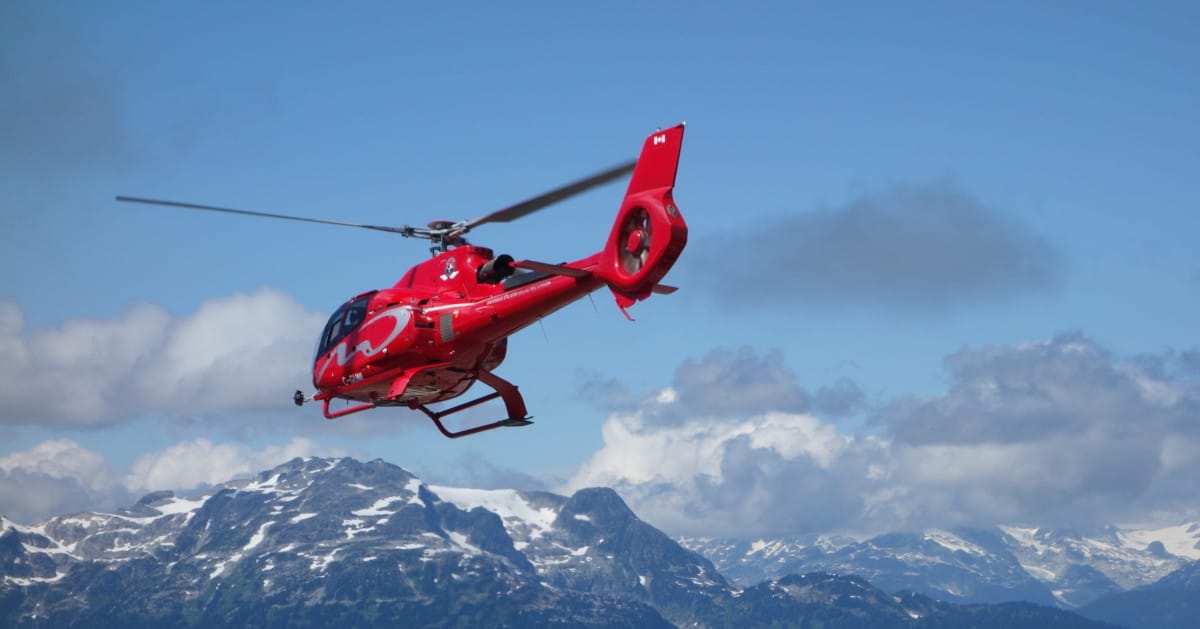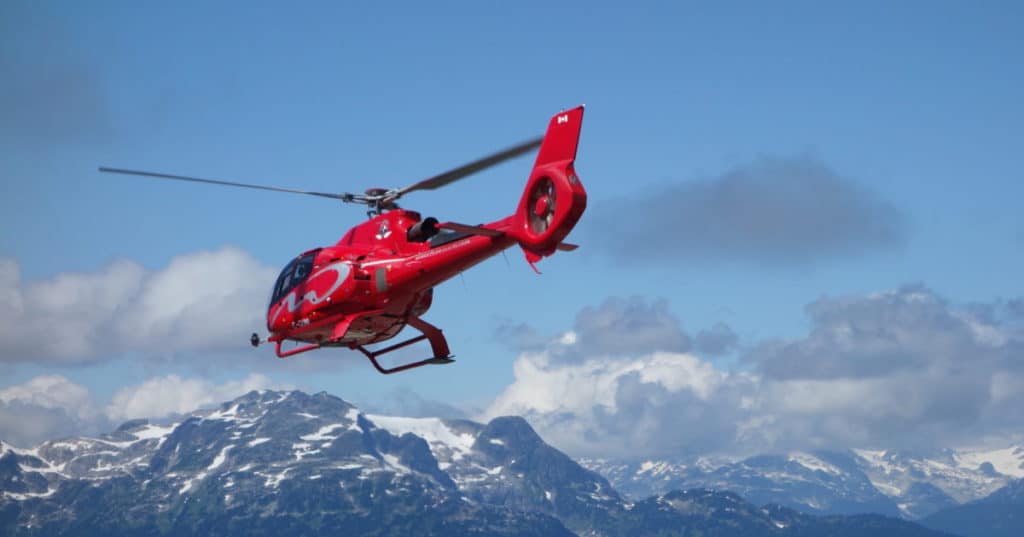
Taking a ride in a helicopter over one of the world’s most beautiful scenic locations is a great experience, but what if the passenger is a large or heavy person? Do helicopters have a passenger weight limit? Do helicopters have a seat width limit, do helicopters have a height limit?
For passengers at the taller or heavier end of the scale, what does this mean for them? Are they able to take a tour flight?
Having been a helicopter tour pilot I have seen passengers of all shapes and sizes. Most helicopter tour companies have a limit for passengers but to find exactly what those limits are please keep reading.
The table below gives a quick snapshot of some of the world’s most popular helicopter tour operators and their maximum passenger weight limits:
| Tour Operator | Location | Seat Limit | Additional Info |
|---|---|---|---|
| Maverick Helicopters | Las Vegas, Grand Canyon, Hawaii | 300 lbs 136 Kg 21.5 Stones | Extra Seat Purchase |
| Papillion Helicopters | Las Vegas, Grand Canyon | 299 lbs 136 Kg 21.5 Stones | Extra Seat Purchase |
| Grand Canyon Helicopters | Las Vegas, Grand Canyon | 299 lbs 136 Kg 21.5 Stones | Extra Seat Purchase |
| HeliNY | New York | 275 lbs 125 Kg 19.7 Stones | Wait For Empty Flight or Purchase Extra seat |
| Blue Hawaiian Helicopters | Hawaii | 250 lbs 114 Kg 17.9 Stones | Wait For Empty Flight or Purchase Extra seat |
| Niagara Helicopters | Niagara, Canada | Width Only | No Weight Limit Must fit on a 14″ Wide Seat |
| Temsco Air | Alaska | 250 lbs 114 Kg 17.9 Stones | Extra Half-Seat Purchase |
| Orbic Air | Los Angeles | 300 lbs 136 Kg 21.5 Stones | None |
Why Do Helicopters Have Maximum Passenger Weights or Widths?
Helicopters have a maximum passenger weight limit of between 250-300lbs because of the crash protection built into each seat, the balance of the helicopter when it lifts into flight, or because of the maximum width a passenger takes up when seated. Typical helicopter seats are 12-14″ wide.
When a helicopter is designed its seating layout is created based on the maximum weight of the occupants that the passenger cabin can hold. For tour helicopters, the maximum seating capacity that can be fitted is usually configured as this allows the tour operator to fly more passengers and generate more revenue.
In doing this there become some limitations to ensure the safety and comfort of ALL the passengers on board. Those restrictions are mainly due to:
- Seat Crash Attenuation
- Seat Width
- Weight & Balance
- Fuel Burn
What is Helicopter Seat Crash Attenuation?
Most seats in a helicopter have a g-force-reducing crumple zone built into them to help dissipate energy from a hard landing before it reaches the passenger’s spine. Some seats may have a weight limit to ensure the crash attenuation system works properly in the event of a hard landing.
Not every helicopter has a seat weight limit, instead, have a limitation where nothing hard or bulky can be placed under the seats. Then there are other helicopters, especially the older ones that have no restrictions and no energy dissipation system built in.
Robinson Helicopters like the popular R44 have a maximum seat limit of 300lbs/136Kg and advise against placing anything bulky in the ‘below seat’ storage area due to this being the seat crumple zone and energy absorption system.
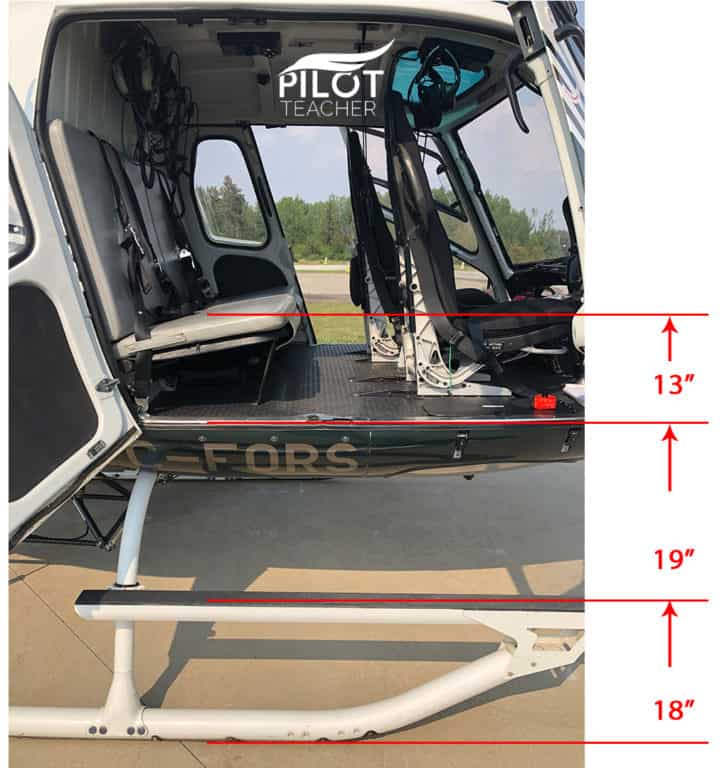
Airbus/Eurocopter Helicopters have no maximum seat limit but do have a crash attenuation system designed into their seat support structure. You can see in the image above the aluminum support system on the front seats. Most tour helicopters will have this on every seat to increase safety for their passengers.
For our helicopter shown, we have a basic rear bench seat for utility operations without the crash attenuation system.

Join My Newsletter & Get Great Tips, Information and Experiences To Help You Become a Superb Pilot!
What is the Average Helicopter Seat Width?
The average width of a seat in a helicopter is between 12-14 inches. On smaller helicopters or tour helicopters with a dense seating configuration, these seats will be moved close to one another. Passengers with broad shoulders and/or wide thighs/pelvis may not be able to fit on just one seat.
If the tour company deems the passenger to be outside of these measurements they will most likely charge for an additional seat to accommodate the space taken up by the passenger. In such cases, the tour company will be able to provide a seat belt extending strap if required.
If you are unsure, it is easy to take a measurement when sitting down and see what your sitting width is. This will give you some idea if you are likely to be charged an additional fee when arriving for a flight.
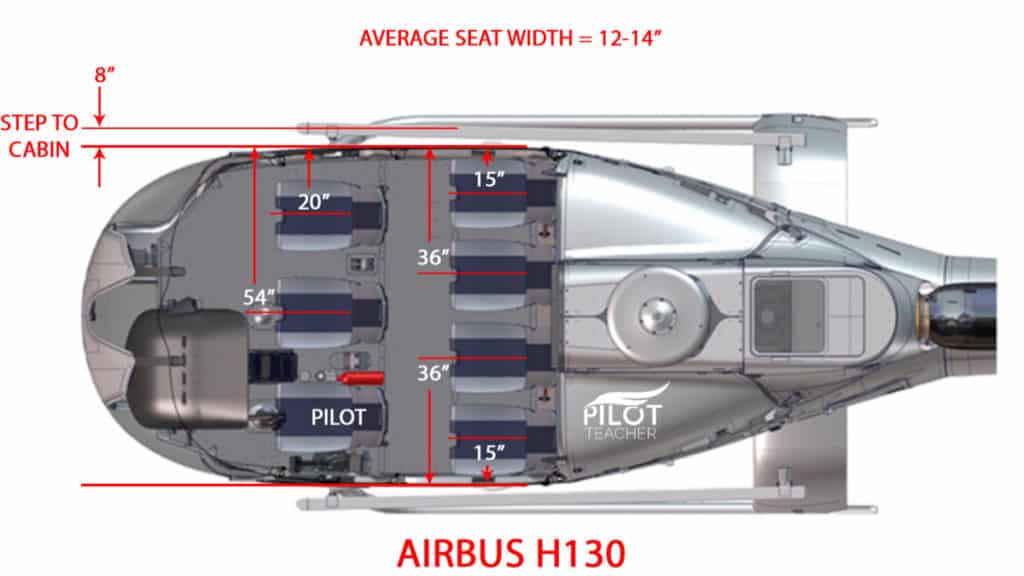
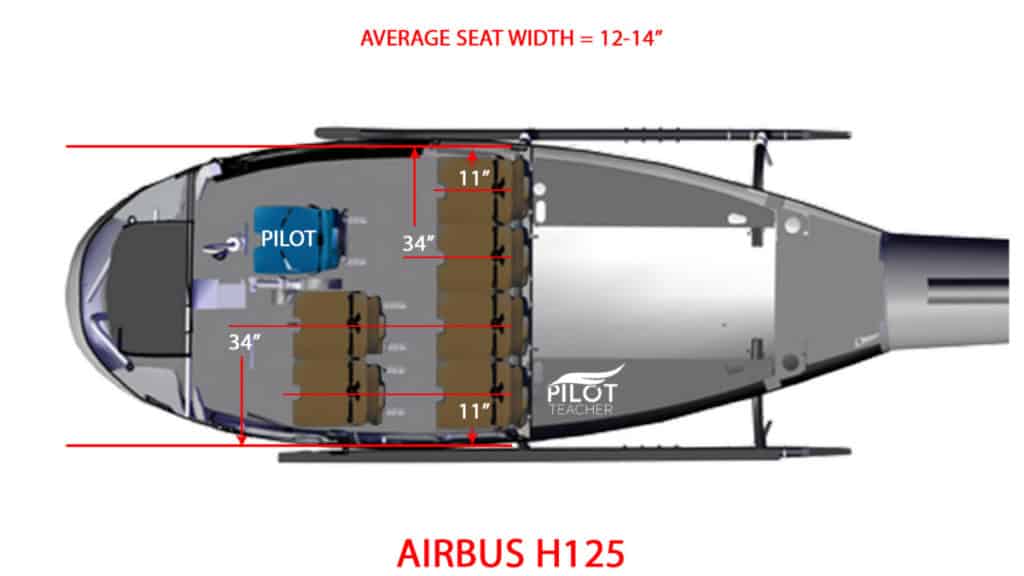
What Is Helicopter Weight & Balance?
When a helicopter lifts into the air it has to weigh less than its Maximum Gross Takeoff Weight. This includes the pilot, passengers, cargo & fuel. The passengers and cargo must also be evenly distributed to ensure the helicopter remains balanced and the pilot has sufficient flight control movement.
Weight – Every helicopter has a maximum certified takeoff weight set by the helicopter manufacturer. That includes the airframe, pilot, passengers, and fuel. The more the pilot and passengers weigh, the less fuel it can carry to ensure it remains under its Maximum Gross Takeoff Weight.
This may be a reason why you have a wait for a flight or two before you can board. The check-in agent will be ensuring all the passengers remain under a set weight limit for the fuel currently on board. If your party is heavy, you will be paired up with lighter passengers, or have to wait until sufficient fuel is burned off by other tours.
When full, the Airbus H125 Astar carries 940lbs of fuel. As this burns off more passenger weight can be carried. At 80% fuel capacity an additional 188lbs can be carried as 188lbs of fuel has been consumed.
Balance – When a helicopter lifts off the ground it has to be balanced. The pilots’ flight controls can only move so far in any direction before they hit their mechanical limits. If a helicopter has a lot of weight on one side, the pilot could run out of control travel trying to compensate in the opposite direction.
This means the helicopter would bank towards the heaviest side and continue to bank over until it rolls over in flight. Think of a person trying to get onto an inflatable pool mattress and they don’t balance properly – they lean their head and torso in the opposite direction to the rolling motion to compensate, but if it is not enough they capsize!
This is another reason why each passenger is weighed and then told where to sit in the aircraft. It’s not to be discourteous to the passenger, it is to ensure the helicopter’s balance remains within its limitations.
Why Do Some Helicopter Passengers Have To Pay Over Weight Fees?
Helicopter tour passengers that weigh more than the tour company’s limit may have to pay a surcharge for fuel. The heavier the helicopter weighs, the more power it requires to fly and the more fuel it burns. Helicopter tour costs are calculated based on a set fuel burn cost.
Most helicopter tour companies will set a passenger weight limit based either on the helicopter’s designed maximum seat limitation or the maximum passenger weight the helicopter cabin can take for the amount of fuel it has to carry. This passenger weight is then divided by the number of seats to set the seat limit.
For Example:
Helicopters Maximum Gross Weight = 4961 lbs
Helicopter Airframe Weight = 3020 lbs
Helicopter Pilot Weight = 180 lbs
Fuel Required for Flight = 450 lbs
4961 – (3020+180+450) = 1311 lbs for passengers
5x passenger seats in the helicopter = 1311/5 = 262 lbs per passenger
or
6x passenger seats in the helicopter = 1311/6 = 218 lbs per passenger
For this tour company operating a fleet of Airbus/Eurocopter AS350 Astars with 5 passenger seats would set a seat limit of 250 lbs/114 Kg to ensure the helicopter remains under its maximum gross takeoff weight for the fuel to be carried.
If a passenger is able to easily fit in just one seat but is over the company limit of say 250lbs, then just a fuel surcharge may be added to the cost of their ticket to cover the extra weight the helicopter must lift and the increased fuel burn associated with it.
If however, the passenger is unable to fit on just one seat then a second seat charge may be incurred as the tour operator has to take one less passenger for that flight.
Most helicopter tour operators will instantly charge for an extra seat once over their set weight limit, but if you see a fuel burn surcharge this is why.
Do Helicopters Have a Passenger Height Restriction?
Most helicopters do not have a passenger height restriction but rather they must be able to physically fit in the cabin. Passengers under 6ft6″ tall can easily fit in most helicopters. Smaller two-seat helicopters may be the most restrictive, but adjustable seats can help accommodate tall passengers.
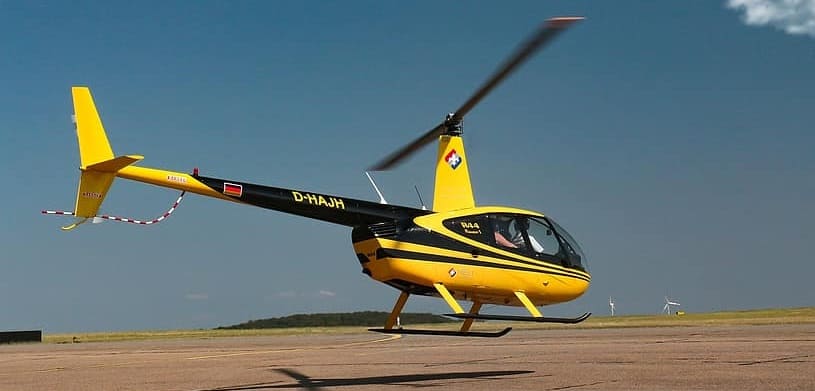
Each type of helicopter has the best seating arrangements for tall passengers. For Example:
- Robinson R44 – Front passenger seat
- Bell 206 – Front passenger seat
- Airbus/Eurocopter Astar (AS350/H125) – Right or left rear outermost seats. Can stretch legs out between the door and front seat
- Airbus/Eurocopter Ecostar (EC130/H130) – Right rear outermost seat. Can stretch legs out between the door and front seat
I know some very tall helicopter pilots and they have no problems fitting in most helicopters. Some are obviously more comfortable than others but they only have the option of sitting in the pilot seat!
Upon arrival at the check-in counter for your tour flight, you can ask for one of the seats mentioned above depending on the helicopter type they operate.
By far the biggest thing to be very careful of is if you are boarding the helicopter when its rotors are turning, be sure to duck as you approach and leave. Tall passengers can come very close to the main rotor blades and whatever you do
DO NOT STICK YOUR ARMS IN THE AIR TO CELEBRATE WHILE NEAR THE HELICOPTER!
Further Help
If you found this helpful and you have more questions about taking a tour flight in a helicopter, then these articles may help you find your answers:

